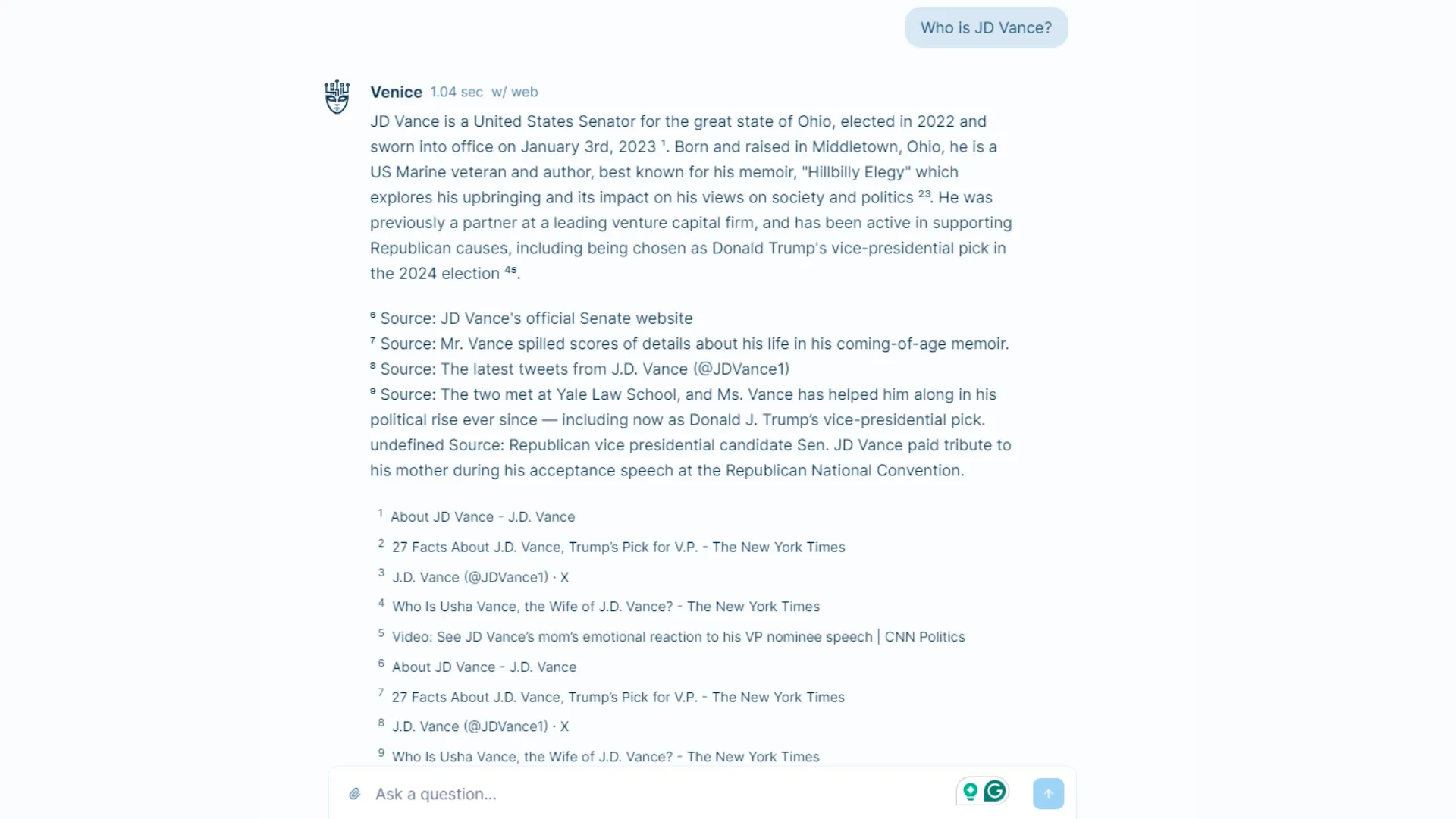In brief
- Venice AI now offers real-time responses using the Brave API to search the internet.
- Search results include citation links that users can click on to confirm validity.
- Venice AI also added share button, enabling users to continue conversations across devices.
Venice AI, the decentralized generative AI model from ShapeShift founder Erik Voorhees, has taken a major leap forward, announcing on Thursday that its service is now connected to the web for real-time responses.
Voorhees launched the privacy-focused Venice AI in May as an alternative to centralized and censored AI models like OpenAI's ChatGPT, Anthropic's Claude AI, and Google's Gemini—touting the project as “a team of crypto folks building an AI app” that's “architected upon the crypto ethos.”
"As always, unlike ChatGPT/Claude/Gemini, all conversations on Venice are private and permissionless," Voorhees wrote on Twitter about the new search capability. "Venice cannot see your messages or the response, and all data is stored locally in your browser. Venice never censors the AI's answers."
Voorhees has said he was concerned that AI was becoming too centralized and controlled by tech giants, making decentralized services necessary.
“I saw where AI is going, which is to be captured by large tech companies that are in bed with the government,” Voorhees previously told Decrypt. “And that really worried me, and I see how powerful AI is, how consequential it can be—an amazing realm of new technologies.”
Before the update, however, Venice AI’s responses were limited to knowledge that was two years old, putting it behind search updates made to ChatGPT and Gemini last year that offered real-time results.
“We only use open source models, and the open source models are always going to be limited by their published date,” Venice AI COO Teana Baker-Taylor told Decrypt. “So the two models that we're featuring at the moment are both versions of Meta’s Llama-3, and it's a fantastic model, but it was published in 2022. And so we knew that that was going to be a challenge for any information that you might be querying the model for that requires data between 2022 and now.”
As Baker-Taylor explained, a key feature that comes with search is Venice AI’s ability to cite sources and provide links to the information it provides.
“I think it's really important when people are questioning or trying to fact-check something or learn new information [that they] know where the information came from," she said. "The model themselves being open source, you can see what the data was that they were trained on and the weights that were given to different parameters.”
While faster and more accurate responses are important to any generative AI model, according to Baker-Taylor, that openness is key.
“This also provides a level of transparency because it tells you exactly where the information was retrieved, it provides a source citing, and it provides you with a greater level of trust that the information is accurate,” she said.
For its search, Venice AI uses Brave’s API for its search results, Baker-Taylor explained, calling the privacy-centric browser company an obvious choice. She noted how Venice AI holds steadfast to its core vision.
“There are a few foundational, fundamental principles that we are building Venice on top of,” Baker-Taylor said. “The first is privacy and that privacy is a human right, and that people should have access to machine learning and artificial intelligence without having... the conversations that they have or the content that they create being attached to their identity, and searchable, reportable, and sellable, for the rest of their lives.”
Baker-Taylor also emphasized the goal of keeping Venice AI uncensored.
“The other key fundamental principle is that access to machine learning should not be censored, and that when you are interacting with these technologies, you should be receiving as close to raw machine learning intelligence as you can without the additional kind of human bias that's baked in that we've seen other platforms deliver.”
In addition to search, Baker-Taylor added that a new feature being rolled out on Thursday is a share button that gives users the ability to share their prompts and messages with others or themselves using an encrypted link.
“Our privacy infrastructure is device-centric, so everything is stored in your browser, it's not stored on our servers,” Baker-Taylor said. “This means you might have one conversation on your phone and another conversation on your desktop, and the two don't meet.
“Now you'll be able to share those chat conversations,” she added, so that once the link is clicked the receiving user can pick up the conversation where the last user left off.
“You don't have to start over, so I think there's going to be a lot of different ways that people use this feature, and we're really excited about it,” she concluded.
Edited by Ryan Ozawa.
Generally Intelligent Newsletter
A weekly AI journey narrated by Gen, a generative AI model.


